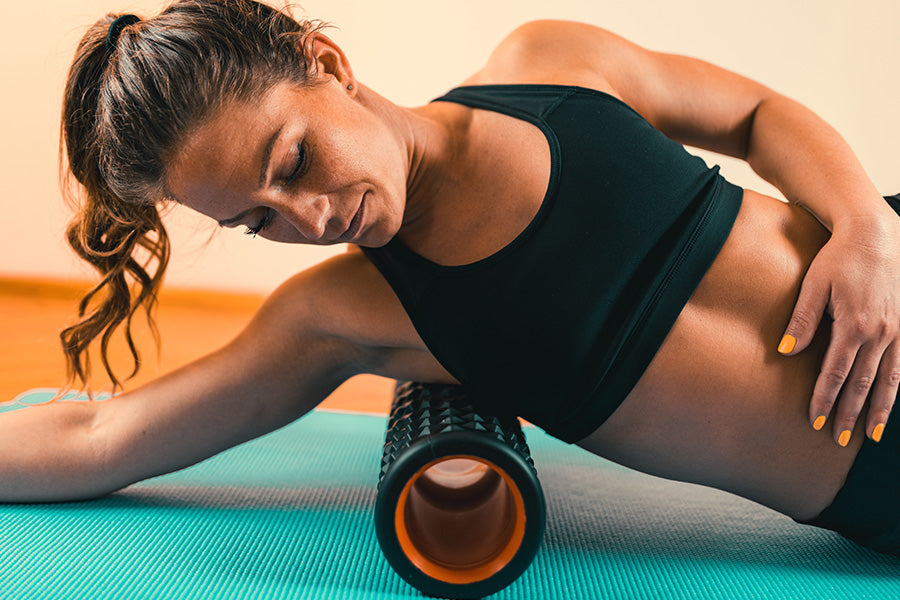You know that feeling. You wake up the day after a killer workout, and every muscle in your body screams at you. You can hardly move without wincing in pain. Enter the foam roller — your new best friend.
Foam rolling is a form of self-massage that may help relieve muscle soreness, improve flexibility, and reduce the risk of injury. When you use a foam roller, you're essentially giving yourself a deep tissue massage. It can help break up knots and trigger points in your muscles, reducing pain and improving your range of motion.
Not sure how to use a foam roller? Read on for six exercises that will help relieve sore muscles. Just remember to start slowly and listen to your body — if an exercise is too painful, stop and try something else.
Related Article: 8 Ways to Relieve Muscle Soreness After Exercise
The Case for Foam Rolling
Multiple connective tissue layers support our muscles, often called fascia. The American Council on Exercise's president and chief science officer, Cedric X. Bryant, claims that physical activity and inactivity can make this tissue stiff or dense. It results in tension throughout a muscle or tightness in a smaller, more localized area — a so-called trigger point or knot — and limiting flexibility and range of motion.
According to physical therapist Theresa Marko from New York City, who also teaches at Stony Brook University, stiff or misaligned fascia is a common cause of muscles and joints unable to move effectively. It can lead people into risky situations when they try to strengthen their shoulders.
Theoretically, according to Dr. Bryant, massaging a muscle over a firm, cylindrical piece of foam accomplishes the same. Foam rolling employs friction to release tension and realign the fascia, like a massage.
Foam rolling for 90 seconds to 2 minutes at a time frequently reduced muscle stiffness and enhanced range of motion, or the ability of joints to move. Foam rolling can, at least temporarily, increase flexibility, or the capacity of soft tissues to elongate, according to other minor investigations.
Studies done over a more extended period revealed that rolling the hamstrings 3 times a week for 4 weeks also increased flexibility.
Using a foam roller as part of your cool-down may help avoid or decrease post-workout pain by encouraging blood flow. According to a 2014 study, foam rolling reduces muscular pain after strength training while enhancing exercise performance, as shown by vertical jump height and range of motion.
Maillard Howell, a personal trainer and Reebok's head of fitness in Brooklyn says that most of his clients exhale sighs of relief after foam rolling. As long as it's done correctly and isn't aggravating your condition, Mr. Howell said, "I don't see a reason not to utilize it if you feel better resting on a foam roller before or after a workout."
Best Foam Roller Exercises
Foam rolling is an excellent way to loosen up your muscles and reduce soreness after a workout. But if you're new to foam rolling, it can be tough to know where to start. That's why we've compiled a list of the best foam roller exercises for beginners.
These exercises will help you get the most out of your foam roller, from core engagement moves to full-body stretches. And if you're feeling determined, you can try them all in one session! So what are you waiting for? Get started on your foam rolling journey today.
1. Upper Back

The upper back stretch can help you loosen up in your upper back and correct bad posture that results from frequently hunching or leaning forward. Aligning your spine, neck, and head also helps.
Steps to Follow
- Lay on your back with a foam roller supporting your head and tailbone.
- Put your feet level on the ground while bending your knees.
- With your palms facing up, extend your arms to the sides.
- Spend up to a minute in this position while taking deep breaths and relaxing.
- Repeat.
2. Thoracic Spine

This exercise straightens your spine and relieves tension in your muscles. It encourages good posture and is helpful for those who spend a lot of time sitting down. Your rib cage finishes in your mid-back, so avoid going any lower.
Steps to Follow
- Lay the foam roller horizontally across your upper back just below your shoulder blades.
- Firmly plant your feet on the ground.
- Lean back and interlace your fingers at the base of your skull.
- To raise the roller toward your shoulders, lift your hips a little.
- For at least 20 seconds, concentrate on the sensitive areas.
- Work up to your shoulders as you progress, and then proceed to your mid-back again.
- Repeat 4-5 times.
3. Lats

This stretch releases stress in your underarm region. Your posture and upper body mobility will both benefit from this.
Steps to Follow
- With the foam roller under your shoulder, lie on your right side.
- Press your left foot stably into the ground while keeping your right leg supported on the floor.
- Start rolling down toward your mid-back from just under your armpit.
- Take a moment to focus on any tender or painful areas.
- Go on for as long as a minute. Shift to the other side.
- Repeat 2-3 times.
4. Gluteus Maximus

Releasing tension in your gluteus maximus aids in easing the stiffness in your legs, besides enhancing the strength and stability of your lower back. It will also help your legs to become more flexible.
Steps to Follow
- Place the foam roller directly beneath your sitting bones as you sit on top of it.
- For stability, place one hand on the ground and the other on your stretched leg.
- Put your feet level on the ground while bending your knees.
- Place your left knee outside of your right ankle.
- Put your left hand on your ankle or thigh, then gradually bend to the right until you feel your glutes stretched.
- Roll from side to side, paying attention to any tender spots.
- Repeat.
Related Article: The Ultimate Guide to Building Bigger and Stronger Glute Muscles
5. Hip Flexors

Long durations of sitting can seriously damage your hip flexors. Although stretching is beneficial to reduce this, foam rolling is even better since it works to release both the muscle tissue and the fascia that surrounds it.
Steps to Follow
- Begin by resting on the foam roller with your back to the ground in a forearm plank posture. Ensure your right leg is comfortably bent to the side, and the foam roller is placed beneath your left hip flexor.
- To target the hip flexor, roll slowly up and down and side to side with the foam roller while balancing on your forearms. Pay particular attention to any trigger points.
- For 30 seconds, repeat this.
- Repeat with the right hip flexor.
6. IT Band

The IT band, made of connective tissue, travels down the outside of the thigh from the hip to the knee. Although runners frequently experience tightness and pain in this area, anyone can benefit from foam rolling.
Steps to Follow
- Laying on your right side, place the foam roller next to your right IT band or outside your right thigh. Your right forearm should support your body weight. Your left knee should be bent, and your right leg should be straight. Your left foot should be placed comfortably in front of your right leg.
- Roll the foam roller carefully along your right IT band between your knee and glute, reviving yourself with your upper body and left leg when you halt at any sore regions.
- Repeat on the other side for 30 seconds.
FAQs
1. Do foam rollers get rid of soreness?
Foam rollers may help eliminate soreness by breaking up the knots in the muscle tissue and improving circulation. It may help minimize inflammation and promote healing. However, research is needed to prove this.
2. Where should you not foam roll?
There are specific areas of the body that you should not foam roll. These include the lower back, neck, and head.
3. Can you overdo foam rolling?
Foam rolling can effectively improve flexibility and range of motion, but it's important not to overdo it. Rolling too frequently or long can do more harm than good, leading to joint pain and stiffness.
Listen to your body and be careful of any signs of discomfort. If you experience any pain, stop rolling and consult a healthcare professional.
4. What is the best time to use a foam roller?
The best time to use a foam roller is after a workout when the muscles are warm and more receptive to the massage-like action of the roller. Foam rolling can also be done to warm up the muscles before a workout.
Final Thought
Foam rolling is an excellent alternative if you’re feeling sore after your last workout or just want to take a break from the gym. Not only is it great for easing muscle pain, but it can also improve your flexibility and range of motion. These six exercises are a great place to start if you’re new to foam rolling, but be sure to mix things up until you find the moves that work best for your individual needs.
So, give these a try next time you need relief from those aches and pains!
Reading List
Post-Workout Recovery: Let Your Sore Muscles Heal
Maximize Your Post-Workout Benefits With These 10 Tips
The Science of Muscle Recovery: How Much Rest Between Workouts for Muscle Growth?
Article Sources
- Adamczyk, Jakub Grzegorz, et al. “Does the Type of Foam Roller Influence the Recovery Rate, Thermal Response and DOMS Prevention?” PLoS ONE, vol. 15, no. 6, June 2020, p. e0235195. PubMed Central, https://doi.org/10.1371/journal.pone.0235195.
- Hendricks, Sharief, et al. “Effects of Foam Rolling on Performance and Recovery: A Systematic Review of the Literature to Guide Practitioners on the Use of Foam Rolling.” Journal of Bodywork and Movement Therapies, vol. 24, no. 2, Apr. 2020, pp. 151–74. ScienceDirect, https://doi.org/10.1016/j.jbmt.2019.10.019.
- Junker, Daniel H., and Thomas L. Stöggl. “The Foam Roll as a Tool to Improve Hamstring Flexibility.” Journal of Strength and Conditioning Research, vol. 29, no. 12, Dec. 2015, pp. 3480–85. PubMed, https://doi.org/10.1519/JSC.0000000000001007.
- Macdonald, Graham Z., et al. “Foam Rolling as a Recovery Tool after an Intense Bout of Physical Activity.” Medicine and Science in Sports and Exercise, vol. 46, no. 1, Jan. 2014, pp. 131–42. PubMed, https://doi.org/10.1249/MSS.0b013e3182a123db.
- Su, Hsuan, et al. “Acute Effects of Foam Rolling, Static Stretching, and Dynamic Stretching During Warm-Ups on Muscular Flexibility and Strength in Young Adults.” Journal of Sport Rehabilitation, vol. 26, no. 6, Nov. 2017, pp. 469–77. PubMed, https://doi.org/10.1123/jsr.2016-0102.








